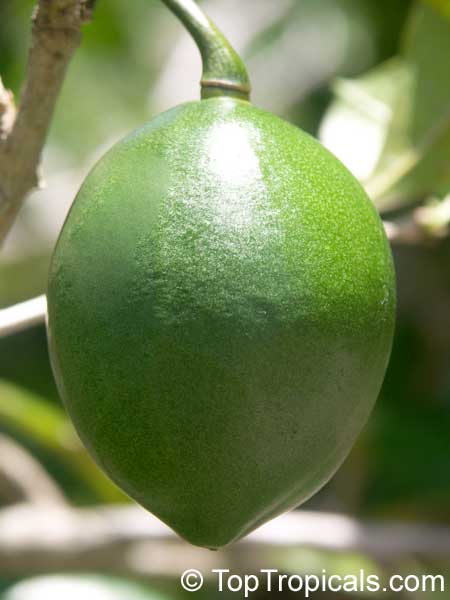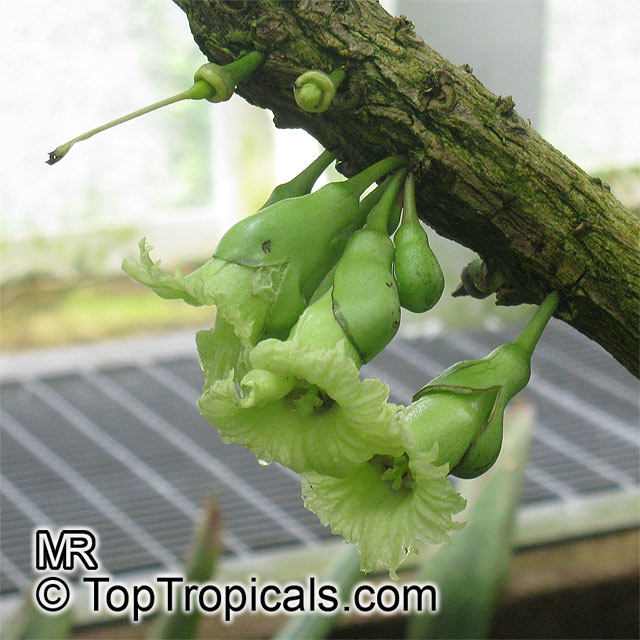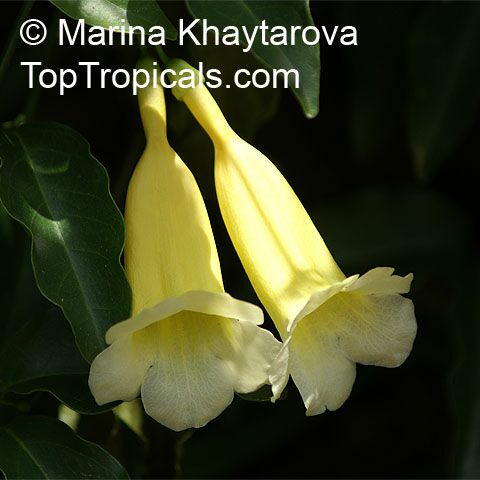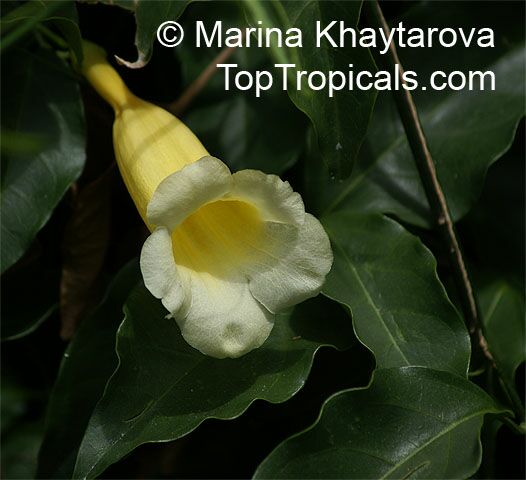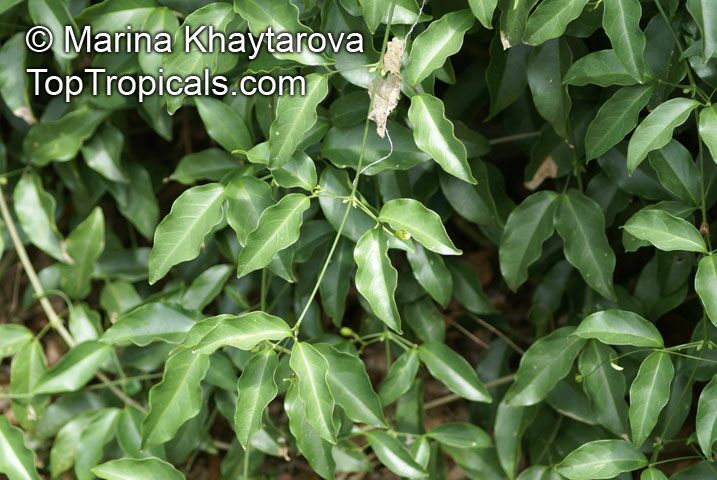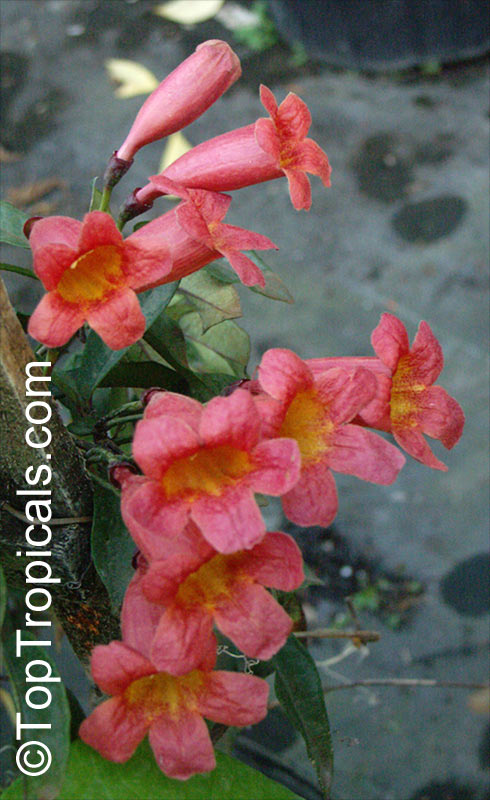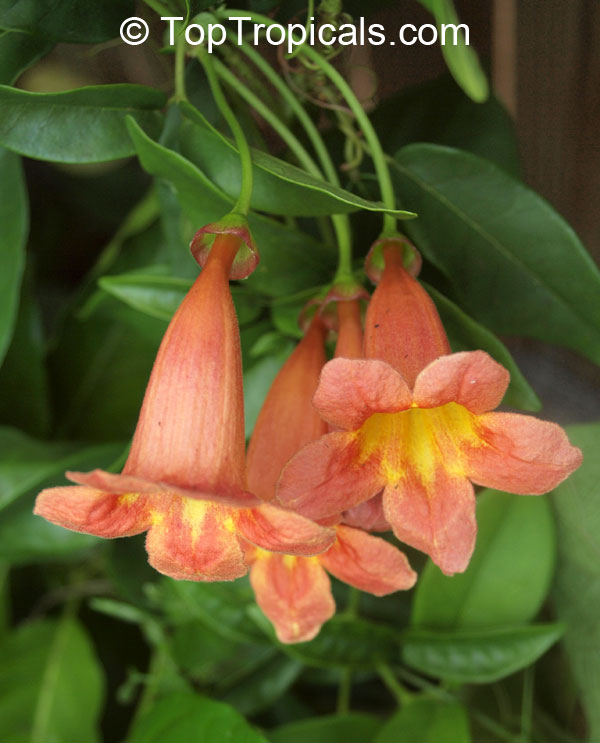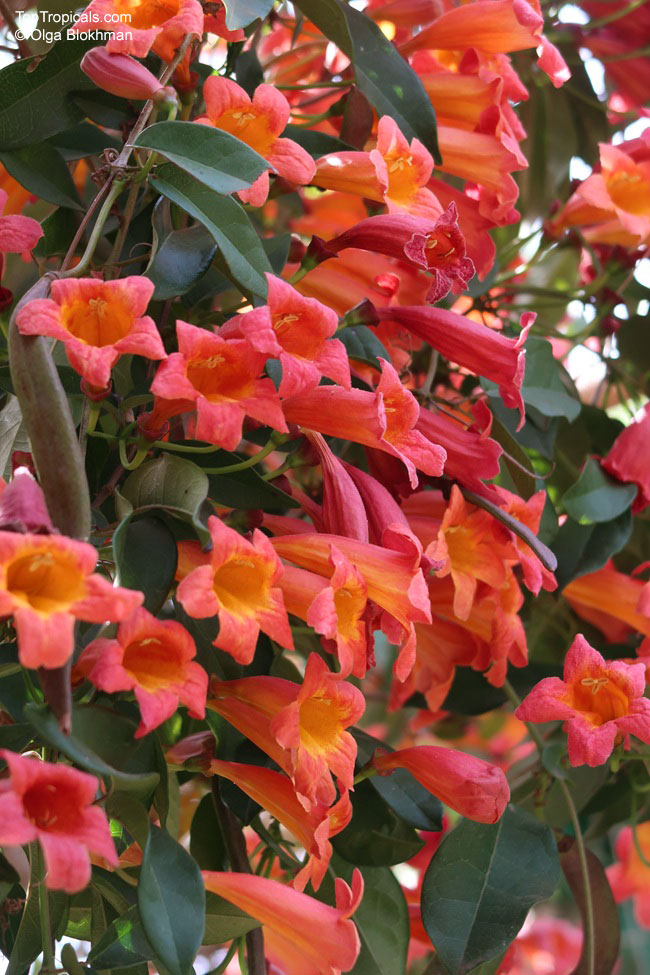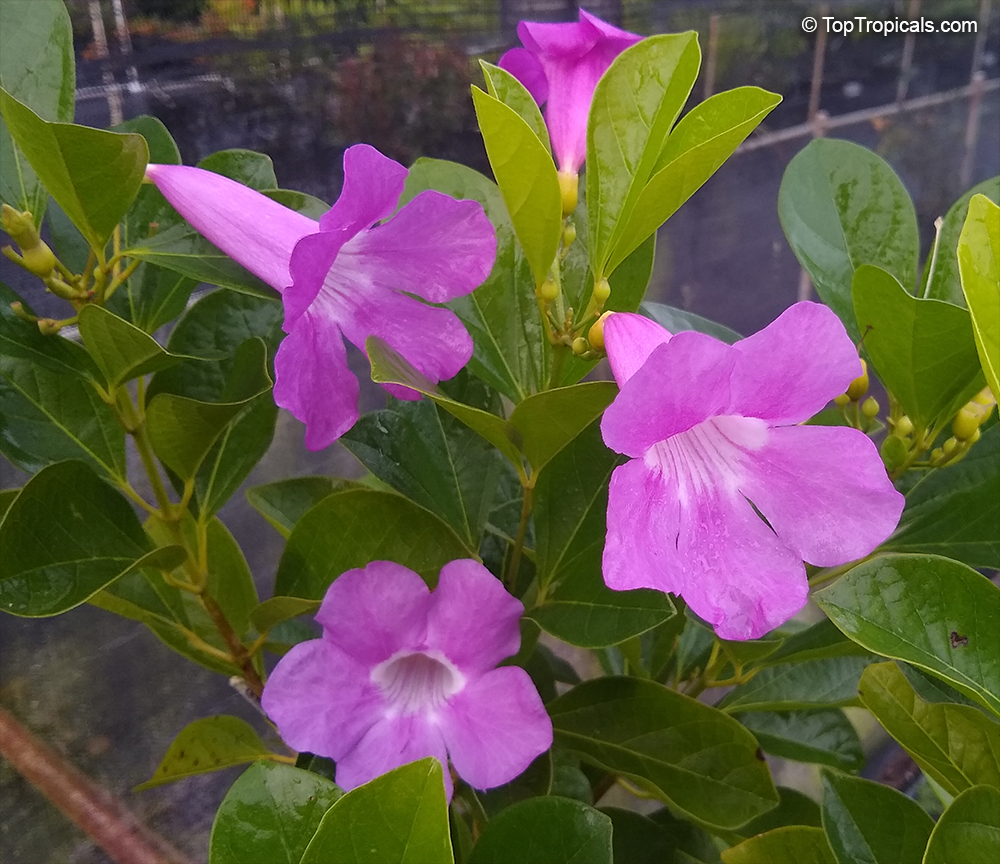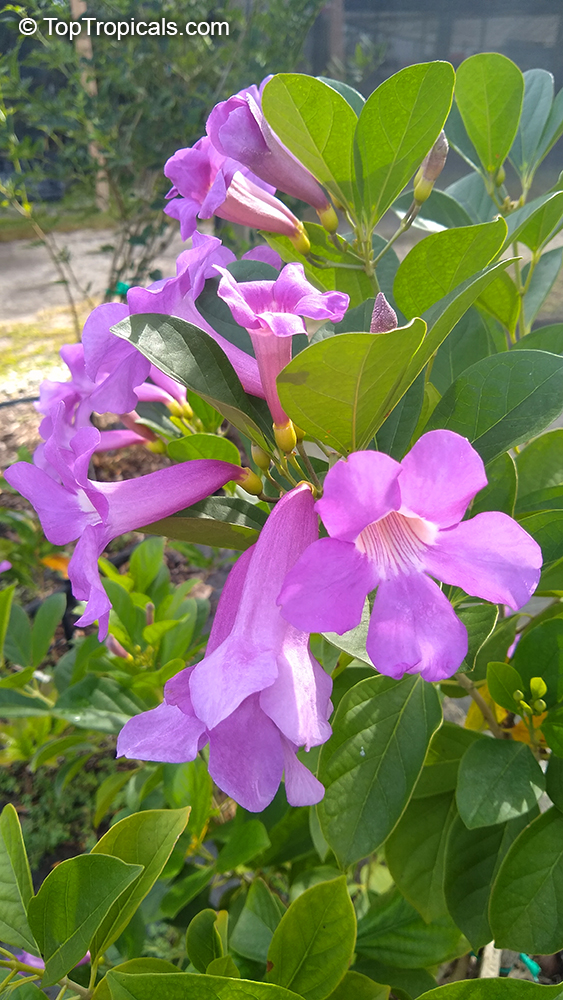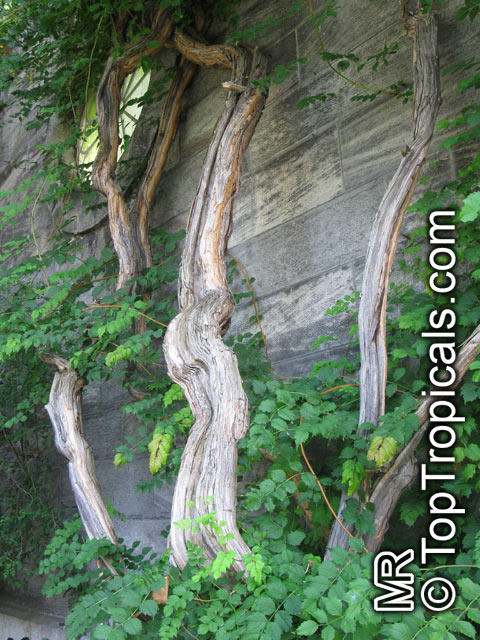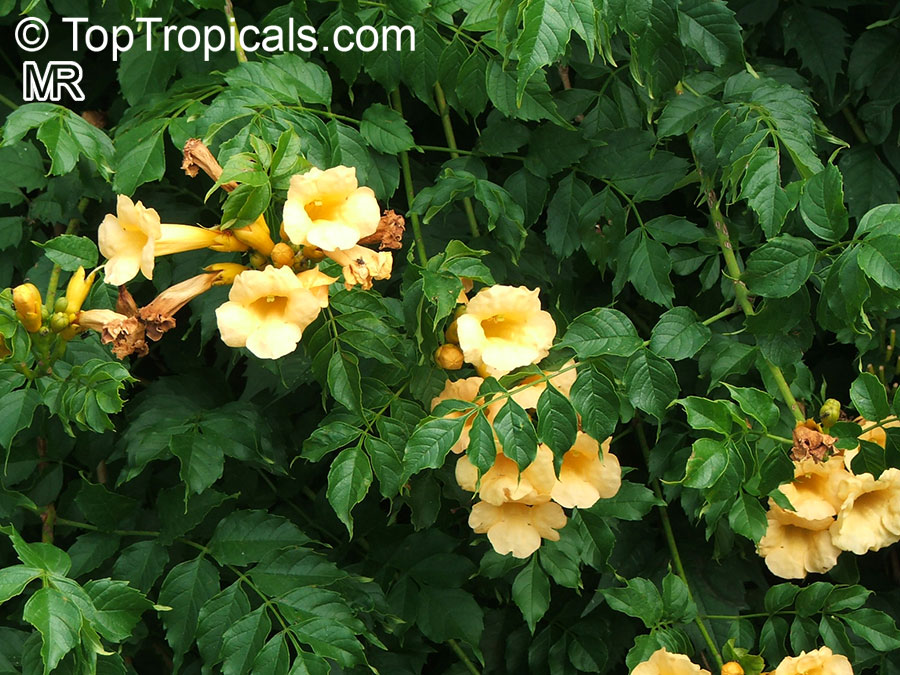Bignoniaceae - Botanical Family
| Number of plants found: 81 | Next | 
|
Go to page: | 1 | 2 | 3 | 4 | 5 | Last |
Botanical names: Adenocalymna comosum, Bignonia comosa
Common name: Yellow Trumpet Vine
Family: Bignoniaceae
Origin: South America





Adenocalymna comosum (Yellow Trumpet Vine) is a creeper native to South America that is renowned for its beautiful yellow and orange flowers. It thrives in full sun or semi-shade and requires regular water to remain healthy. It is suitable for growing in USDA Zones 9-11, making it a great option for gardeners living in mild climates.
Yellow Trumpet Vine is an evergreen vine and needs support to grow on, such as trellis or wire. Its leaves are small, lanceolate and arranged in opposite pairs. It flowers in early spring producing many long tubular yellow or orange flowers, grouped in terminal plume-like inflorescences. The flowers open successively and display a steady flowering state over several weeks.
If you are growing the Yellow Trumpet Vine in a pot, then it is best to use a well-draining soil with a slow-release fertiliser. In cooler climates, it is best to move the pot indoors in winter to provide protection from frost. To encourage healthy growth and flowering, deadhead any faded flowers, and prune the plant if it gets too large or leggy. A yearly prune will also help to keep the plant from becoming unruly.
With its beautiful flowers, Adenocalymna comosum is a great addition to any garden. With its easy-care requirements and ability to thrive in mild climates, the Yellow Trumpet Vine can be a real showstopper in any outdoor space.
Botanical names: Amphitecna latifolia, Enallagma latifolia, Dendrosicus latifolius, Crescentia latifolia
Common names: Black Calabash, Jicarillo, Savanna Calabash
Family: Bignoniaceae
Origin: Costa Rica








Irregularly shaped tree with a bent and twisting, angular trunk. Simple, alternate ovoid leaves, thick and stiff. Waxy, glossy, and dark green, they contrast markedly with the lighter bark of the branches and twigs. Solitary flowers may be found growing amid the foliage or directly from the sides of the bare sections of the larger limbs and even the trunk. They are large, white, and composed of four thick petals fused into a bent and angular corolla tube that flares distally into a trumpet. The green calyx that covers and protects the developing flower during its early development is also fused into one piece, and it splits irregularly when the blossom finally emerges. Five long, black-anthered stamens and a central pistil are found within the perianth. Flowers are nearly present throughout the entire year. Fruits are large (4"in diameter), ovoid, indehiscent green pods with a smooth, glossy texture and an appearance similar to the fruits of the Jicaro (Crescentia alata ) tree. Inside the thin, woody skin of the pod is a white fleshy pulp that surrounds several black seeds. The white pulp and seeds of the fruit are edible. Jicarillo wood is reportedly hard and rot resistant.
Pollination: "Members of this genus are not bee pollinated - the flowers have peak nectar production at night, and you'll notice that they produce quite a lot of nectar. Bees are generally after the pollen, they would probably drown in all the nectar this species produces. The flowers are also pretty big - these are bat pollinated. The bees will certainly visit, but they are not effective transferrers of the pollen to the stigma". (By Susan Grose)
Botanical name: Amphitecna macrophylla
Common name: Bigleaf Black Calabash
Family: Bignoniaceae
Origin: Mexico, Guatemala





Botanical names: Anemopaegma chamberlaynii, Bignonia chamberlaynii
Common name: Yellow Trumpet Vine
Family: Bignoniaceae
Origin: Brazil





Botanical name: Bignonia capreolata
Common name: Crossvine
Family: Bignoniaceae
Origin: North America
Hardiness: 15°F









Fast-growing cross-vine with unique leaves - two leaflets per leaf; the rachis ends with a tendril. The common name comes from the cross shape seen when you make a cross-section of a stem, makes an outstanding screen. Will scramble up a trellis or any other support quickly and easily. It is hardy and relatively pest free. The deep red buds in spring open to reveal a cheery yellow inside. Unscented tubular flowers appear in late April. Prune as desired.
Botanical names: Bignonia magnifica, Saritaea magnifica
Common names: Glowvine, Purple Bignonia, Saritaea
Family: Bignoniaceae
Origin: Colombia








It is an evergreen woody vine native to Colombia that flowers during the summer.
Glowvines reach between 10-15 feet of height and spread at the same rate. They grow best in full sun or semi-shade, provided they have access to regular water in the summer months when the blooming is at its peak. To achieve the most lush flower production, fertilization should take place during the growing season. Plant care will be easier if they are grown in pots during the winter in colder regions.
The flowers of Saritaea magnifica, also known as Glowvine, come in shades of blue, lavender and purple and attract butterflies, bees, and hummingbirds due to the bright colors and sweet nectar. This vine blooms starting in the spring and continues up until the fall creating an array of colors in the garden.
Glowvines are suitable for growing in the USDA Zones 9-11 and can be great for creating a vibrant landscape. While this plant is not frost hardy and can suffer from cold temperatures, if grown in pot, it can likely be brought indoors during the winter months to ensure a longer lifespan.
Botanical names: Campsis grandiflora, Bignonia grandiflora, Campsis chinensis
Common name: Chinese Trumpet Creeper
Family: Bignoniaceae
Origin: China










A rapid-growing vine that provides excellent cover for fences, walls, arbors or large trellises. May also be grown on the ground to cover tree stumps or rock piles.
Needs support; partly twining; few aerial roots.
Hardiness Zone: 7-9
Campsis × tagliabuana 'Madame Galen' is a hybrid between Campsis radicans and Campsis grandiflora.
Botanical name: Campsis radicans
Common names: Scarlet Trumpet Vine, Red Bignonia, Blood Trumpet, Dynamic Trumpet Vine
Family: Bignoniaceae
Origin: Eastern USA to Mexico










This is a fast growing evergreen vine reaching 30 feet tall. Beautiful red orange tubular blooms with yellow throat that blooms in clusters, each bloom is up to 3 inches long. Starts to bloom in early spring and continues all summer. Can take some frosts, somewhat hardy. Can be trained as a standard. Prune to keep under control. Incredibly beautiful. Once established does not need to be watered or fertilized beyond what nature provides. Can withstand long periods of drought even in growing season and does not seem to stress it at all, it keeps blooming. Propagation Methods: From semi-hardwood cuttings, by air layering. Environmental extremes tolerated. Plant in full sun to part shade and water occasionally in the summer, do not overwater. It is hardy to about 25-30 degrees F. If it is well-established, it should regenerate from the roots if it freezes down to the ground.
Campsis xtagliabuana 'Madame Galen' is a hybrid between Campsis radicans and Campsis grandiflora.
Related species: Distictis buccinatoria.
Botanical name: Catalpa bignonioides
Common names: Southern Catalpa, Indian Bean Tree
Family: Bignoniaceae
Origin: North America









It is a valued ornamental tree with large foliage and showy clusters of flowers in the spring.
Catalpa x erubescens 'Japonica' - hybrid between C.ovata x C.bignonioides.
Botanical name: Catalpa longissima
Common names: Yoke-Wood, Haitian Catalpa, Jamaican Oak
Family: Bignoniaceae
Origin: West Indies








Tall tree from the West Indies where the hard wood is used for carts and other construction.
| Next |  |
Use link to repeat this search:
https://toptropicals.com/cgi-bin/garden_catalog/cat.cgi?search_op=and&keyword_op=and&language=e&family=Bignoniaceae
&number=10&no_change_lang=1&user=tt&sale=1&first=0







